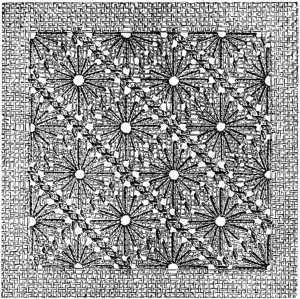Eighteenth pattern (fig. 161).—Small squares of 7 stitches, inclined alternately, to the right and left, and so formed, that the longest stitch of one square is crossed by the first short stitch of the next, so that a space only 6 threads wide and 4 long, remains uncovered. The intervening stripes are filled with 3 rows of overcasting stitches, covering 2 threads each way.
Nineteenth pattern (fig. 162).—The steps formed by this pattern are 11 stitches high, and 11 wide, and each stitch covers 4 threads.
Eight threads intervene between each row of steps, which are covered at the bend, by a square of stitches, from the last of which, the thread is carried on at once, to the four single stitches.
Twentieth pattern (fig. 163).—The 4 squares set opposite to each other, with 2 threads between, are edged all round by 3 rows of overcasting.
Twenty-first pattern (fig. 164).—Begin by rows of stitches, like those described in fig. 155, over 4 and 2 threads, with 4 threads between, not counting those covered with cross-stitch. Between the two rows of cross-stitch, join 6 threads together by a back-stitch, and carry your thread over the two last of the 6, to the 2 first of the next cluster. The narrow diagonal stripes are separated by 24 threads, exclusive of those covered by the cross-stitches. These spaces are filled in with squares, 10 threads wide and 10 long, formed by back-stitches crossed on the wrong side.
Twenty-second pattern (fig. 165).—In the closer stuffs, of a coarse texture, the threads of which do not admit of being drawn together, as you can those, of a loose thin stuff, where, by simply pulling your thread a little tighter you get open spaces, you must begin by cutting out every fourth or fifth thread. After which, you overcast all the rows, first one way, and then the other, with stitches covering 4 threads, each way. On this foundation with strong, loosely-twisted cotton, Coton à broder D.M.C or Coton à tricoter D.M.C No. 25, 30, 35, or 40, make long stitches, as indicated in the illustration.
Twenty-third pattern (fig. 166.)—From the point where the thread comes out of the stuff, make 16 stitches, four times over, all coming out of the same hole, over 8, 6, 4 and 6 threads, thus forming a star. Leave an interval of four threads between the stars, and unite the intervening threads by cross-stitches one way, and whip-stitches, the other.
Twenty-fourth pattern (fig. 167).—Make a succession of diagonal stitches, increasing in length, and advancing one thread at a time, until the seventh stitch covers seven threads, and completes the triangle. Then begin a second triangle on the nearest, adjacent thread.
Twenty-fifth pattern (fig. 168).—Cover your whole surface with squares of 16 stitches, as in fig. 147, and fill in the intervening squares with 23 stitches, all radiating from one centre.
Twenty-sixth pattern (fig. 169).—Diagonal trellised stripes, made as indicated in fig. 165, and overcast, form the ground. Twelve threads are to be left between the stripes, upon which, work six-cornered, lozenge-shaped groups of stitches, set at right angles to each other, in diagonal rows.
Twenty-seventh pattern (fig. 170).—We conclude our chapter with a circular design, which combines a variety of stitches, and introduces our workers to two new patterns, as well as to an advantageous way of hiding the junction of several kinds of stitches by semicircles of button-hole stitching.
FOOTNOTES:
 Stripe in flat and raised satin stitch, and madeira embroidery.
Stripe in flat and raised satin stitch, and madeira embroidery.










